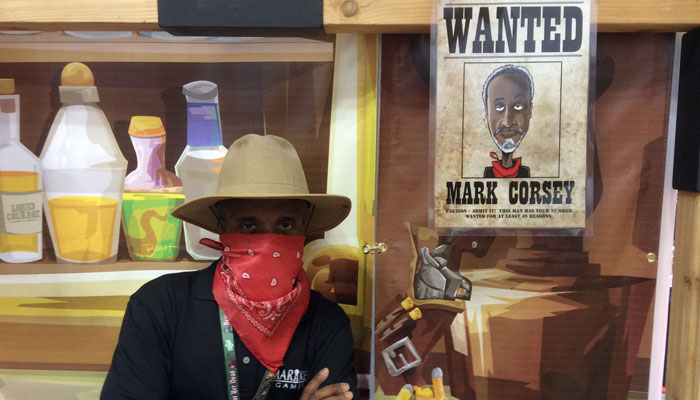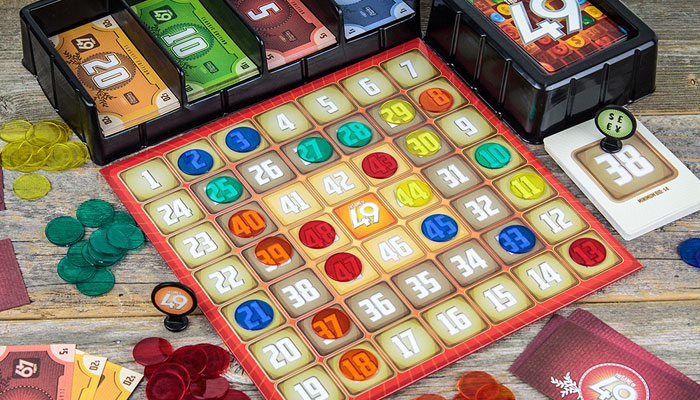The Game of 49’s Mark Corsey on why game design is as much about endurance as it is about invention

Since becoming a published game designer, Mark Corsey has had to stop saying, “hey, don’t look at me, I didn’t make the rules!”
Seven years after having the idea for The Game of 49, it finally landed on shelves courtesy of Breaking Games, and his follow-up, a house of cards game called Deck Construction, is due out later this year – almost 20 years since the concept first came to him.
We caught up with Corsey to find out more about the story behind his first published game, and why the design process is as much about endurance as it is about invention. Oh, and he assures us that in game playing and in general, he plays by the rules; he only dresses like an outlaw.
What is your history in the world of game design?
The Game of 49 is my first published design. My second, Deck Construction, is slated for publication later this year. Both are from Breaking Games, and they share a similar backstory in that each was designed years before being published.
I created 49 in 2009 but didn’t find a publisher and so put it aside. The feedback from my ongoing playtesting was consistently positive though, so in 2014 I took the do-it-yourself approach and Kickstarted the game – with a $4,900 goal, of course – and produced a small print run.
Deck Construction, my ‘newer’ game, actually predates 49 by about a decade; I created it in the late 1990s. There was interest from a small mainstream publisher at the time but in the end, no sale.
I revisited the design several times over the years, but the Breaking Games edition will be very consistent with my original design of twenty years ago. I like to think that both games were inspired by Pinocchio, in that they spent their time on my shelf dreaming of someday becoming a ‘real toy’ that people could play with – and that I’ve made their dreams come true, just as they’re fulfilling my dream of being a published game designer.

Where did the idea for The Game of 49 come from?
At a game night at a friend’s house I was introduced to an old-school game called The Game of 99. It’s a 5-in-a-row game played on a 10 x10 square pegboard and driven by number cards. (The same game has been reissued several times, most recently as 5ive Straight.)
I liked the game immediately – not least because I won it my first time at the table – but I felt that luck of the draw played too big a role. So 49 grew from an ‘I like this game, but what if…?’ moment.
Can you talk us through some of the key design decisions behind The Game of 49?
My first goal was to make players compete for every card as it came available, rather than being able to claim a good card just by drawing it; hence, the auction mechanic in 49. I decided on a smaller board and a faster win condition to keep the playing time short – a 7 x 7 board instead of 10 x 10, and a 4-in-a-row objective instead of 5-in-a-row.
I also chose the 49-square board because having an odd number of rows and columns creates a single centre space that can function in some special way. In the case of 49, that centre space evolved to be both the most vulnerable and, potentially, the most powerful on the board, so players agonise when deciding how much to bid for it. Did I mention that I love making players agonise?
Other particulars, such as minimum bid amounts for number cards and payoff amounts for wild cards, fell into place relatively quickly once I’d settled on the broader parameters.
I’ll anticipate an unasked question by saying: No, I never thought seriously about giving the game a theme. I like the simplicity and familiarity of a numbered grid. Everyone has played bingo or snakes and ladders, so newcomers feel comfortable with 49 right away, even after they discover that the gameplay has a good deal more depth than meets the eye.
One of my most gratifying experiences to date was seeing how quickly a group of students from Japan understood the game despite having a limited mastery of English. I’m very pleased with how accessible the no-theme implementation has been.

How do you stay creative?
Staying creative to me means, mostly, ‘staying’. Staying at it. Like a lot of folks, I have plenty of game ideas. But marshalling an idea from concept to completion involves at least as much endurance as invention.
Do you think the games space is in a good place creatively at present?
As a once-published tabletop designer – someone for whom this work is a passion but not (yet!) a profession – I can only claim limited insight into the overall games space.
It seems safe to say that tabletop game players enjoy an embarrassment of riches at the moment. And aspiring designers have access to more peer support and professional training, and more opportunities to publish or self-publish, than at any time in my experience.
With so many good new games flooding the market, others inevitably get washed away too soon. But in spite of that, I see these as the good old days, and I’m enjoying them.


























